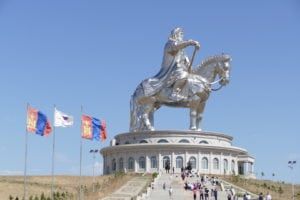New for 2020 is the option to extend your Gobi Discovery Tour and enjoy the Nadaam Festival, Mongolia’s version of the Olympics.
 Naadam History
Naadam History
The festival has existed for centuries in various forms. Originating in military exercises, it later served as a way to train soldiers for battle, becoming a festival during the Chinese Qing dynasty’s rule. Now it commemorates the 1921 Revolution when Mongolia declared independence from China and coincides with Mongolian State Flag Day.
The festival, celebrated every July 11- 13 is steeped in history and features competitions in three “manly” sports (called the Danshig Games) linked to qualities necessary to be an esteemed warrior. Women now participate in archery and girls compete in horse-racing. Wrestling is still an exclusively male domain.
Opening Ceremony
The festival begins with an elaborate introduction ceremony featuring political leaders, dancers, athletes, horse riders, and musicians. Spectators dressed in colourful, traditional costumes applaud parades of mounted cavalry, athletes, and monks. After the ceremony, the competitions begin.
Competitions
Horse Racing
Patience and bravery are tested by competitors through their ability to train and ride horses. A cloud of dust ten miles away becomes black specks of riders, growing as they approach. As they emerge, they’re often young boys decked out with eagle feathers and blue rags tied to their horses for good luck!
Wrestling
Multiple fighters wearing special leather boots with an upward toe and not much else tussle on the arena floor. Each often huge contender performs an eagle dance for good luck, then fights. Wrestling demonstrates the competitor’s strength, flexibility, and movement.
Archery
Ghengis Khan’s armies were famous for their archery skills, honed on compounded bows which outperformed English longbows. Archers are prized primarily for their hand-eye coordination.
Additional Features
In addition to the sports competitions, the Naadam festival provides insight into Mongolian culture through displays of cultural song, dance, and costumes. Throat singing, the hauntingly beautiful sound of traditional horse head fiddles, and distinct displays of clothing from each of Mongolia’s more than twenty ethnic groups fill out the festivities.
Resources:

